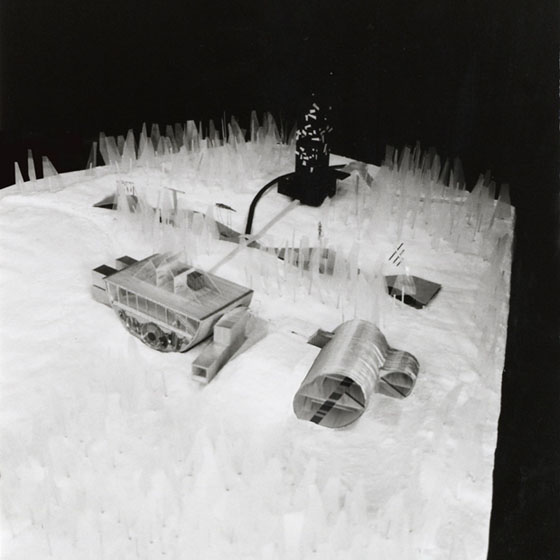
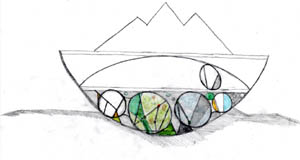
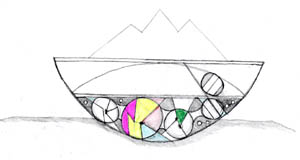
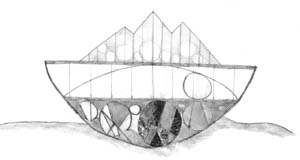
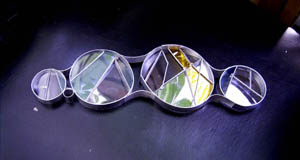
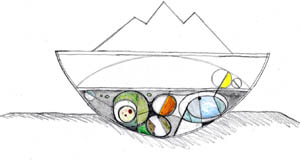
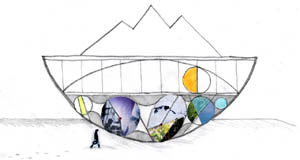
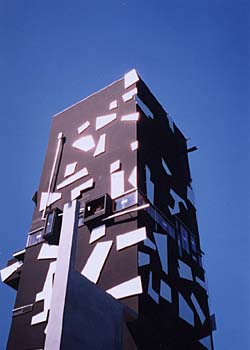
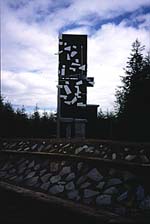
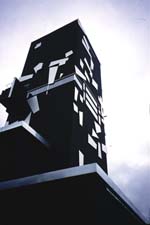
Osamu Ishiyama
Published in cooperation with JFDA Japan Finland Design Association / April 2001
English translation by Bruce Holcombe
On Japan's northernmost island, Hokkaido, a Tower of Silence is under construction.This
structure is located on top of a hilock in the Tokachi wilderness, which is where one of the
island's native peoples, the Ainu, live. The owner (the client) is the Hokkaido Tenji (Japanese
Braile) Library, which is an Obihiro organization, one of the few in Japan boasting such a
history of work for the blind. this library for the blind was opened in commemoration of Helen
Keller's visit to Japan.
The official name of the Tower of Silence under construction is the Seizansou Helen Keller Commemorative Tower. The Tower, standing in the Hokkaido wilderness, is small in scale. Inside there are four levels. If the wind is blowing, the less than 20-metre high, slender tower seems to waver in the breeze. It is unique in the ingenious ways it seeks to enable enjoyment by the visually impaired as well. The clear attempt to go beyond the framework of convential functional architecture through these ingenious devices is also valuable. Modern design has invariably emphasised visual values and discarded most others. The Tower of Silence being built in Tokachi has been contrived rather to highlight visual values, but in another sence.
Focus on the imaginative power of the blind and respect for their dignity is what underlines the design of the Tokachi Tower of Silence. How much astounding imagination is bubbling in the unlit space inhabited by the blind? And how many important discoveries can be made in considering the future of design from this very freedom within lack of freedom?
Each of the levels inside the tower is unusually dark, replete with the dim light eschewed by modern design. Both the blind and the seeing will experience in a profound way the possibilities of that darkness. It is said that the blind do not know the azure blue of the sky. Nor the splendour of a sunset. And yet, perhaps because of that disability, they surely know an astounding sensory world that we do not. A deep knowlede of a world of sixth and seventh senses surpassing the five senses. So this tower is entirely an experimental structure to experience sensations that can only be gained by sharing the darkness of the blind.
Why call it a Tower of Silence? Because it so full of all kinds of sounds. First, as people approach the tower, they will hear, if the wind is blowing that day, a sound like a subtle reed. On the Balinese Hindu island of Bali there is an unusual musical instrument called the sunari, which is a bamboo rod with various shaped holes. When the wind blows it produces a reed-like sound. Various sunari, wind-bells, and wind harps are incorporated in the tower. Thousands of different sounds will be perfomed depending on the vagaries of the breeze. The fine wires attached to the corners will resonate with a consummate music and the edges of the aluminium panels on the surface will produce fine sounds. Both snow and ice will adhere to the tower and sometimes, clothed in ice, it will undoubtedly play a rousing symphony in the blizzard.
On rainy days, both inside and out, the tower will perform an amazing watery quartet. The guttering on the inside and outside of the tower is designed in a complex configuration so that people can enjoy the sound of the water as it flows down in small waterfalls. The design is such that rain falling on the tower is collected in one place and then flows for about one hundred metres. This rivlet will produce only a minor body of water and yet I am sure there will be some people who will enjoy its music. In winter it will form a large icicle, which will generate sounds and warm the hearts of those who experience it.
The interior is also an assembly of sounds. The sound of the gravel on the floor will suggest the wash of the ocean. There also be the sound and aroma of candles melting. And the sounds of water and the creaking of boards. These will offer people an intellectual enjoymennt beyond the pleasure of the senses. The second-floor bathing area, including the outside terrace,is a complete floor of the tactile sense. The priority of the senses has guided the construction of the entire space. Just imagine that the water in the bath has overflowed to cover the whole floor. As though one is enveloped in water, this space envelops the body through the senses. It is a pool of the senses. The third floor is a dark tearoom. Relying on the faint light, sound, touch and smell, everyone, both the blind and the seeing, can eperience the atomosphere of an extermely sensual place.
The fourth floor is a small cathedral of silence. Here people are freed from visual design, the greatest contemporary noise, and can feel the warmth of the rays of the setting sun on the Ainu holy mountain Poroshiri-dake just visible through small cracks and the light faintly piercing the darkness of the interior.
A very intricately designed darkness thus fills the interior of the tower. Visible objects are hidden in an extremely controlled darkness. That is the origin of the Tower of Silence.